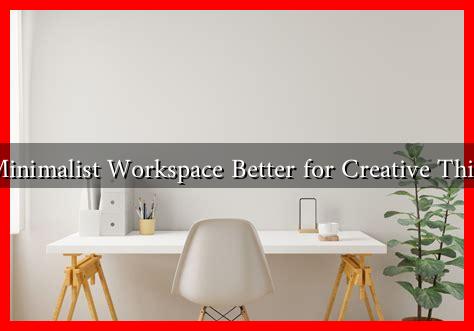-
Table of Contents
Is a Minimalist Workspace Better for Creative Thinking?
In an age where distractions are abundant and information overload is the norm, the concept of a minimalist workspace has gained traction among professionals and creatives alike. But does a minimalist environment truly foster better creative thinking? This article explores the relationship between workspace design and creativity, examining the benefits of minimalism, supported by research, case studies, and practical examples.
The Essence of Minimalism
Minimalism, at its core, is about simplicity and intentionality. It encourages individuals to focus on what truly matters by eliminating excess. In a workspace context, this translates to a clean, organized environment that minimizes distractions. The principles of minimalism can be applied in various ways:
- Decluttering physical items
- Reducing digital distractions
- Creating a streamlined workflow
By adopting a minimalist approach, individuals can create a space that promotes clarity and focus, essential components for creative thinking.
The Psychological Impact of a Minimalist Workspace
Research indicates that our environment significantly influences our mental state. A study published in the journal *Environment and Behavior* found that cluttered spaces can lead to increased stress and anxiety, which can stifle creativity. Conversely, a minimalist workspace can enhance cognitive function and promote a sense of calm.
Here are some psychological benefits of a minimalist workspace:
- Reduced Stress: A clean environment can lower cortisol levels, leading to a more relaxed state conducive to creative thinking.
- Enhanced Focus: Fewer distractions allow for deeper concentration, enabling individuals to immerse themselves in their creative processes.
- Increased Clarity: A minimalist workspace encourages clear thinking, making it easier to generate and develop ideas.
Case Studies: Success Stories of Minimalist Workspaces
Several successful companies have embraced minimalist design principles in their workspaces, leading to enhanced creativity and productivity. For instance:
- Google: Known for its innovative culture, Google incorporates open spaces and minimalistic design in its offices, allowing for collaboration and creativity to flourish.
- Apple: The design of Apple’s headquarters, Apple Park, reflects minimalism with its clean lines and open spaces, fostering an environment that encourages innovation.
- Basecamp: This project management software company promotes a minimalist approach in its office design, emphasizing simplicity and functionality, which has contributed to its creative output.
These examples illustrate how a minimalist workspace can lead to a more innovative and productive atmosphere, ultimately benefiting the organization as a whole.
Statistics Supporting Minimalism in Workspaces
Several studies have quantified the benefits of minimalist workspaces:
- A survey by the *American Psychological Association* found that 61% of employees reported feeling more productive in a clean and organized workspace.
- Research from *Steelcase* revealed that 90% of employees believe their workspace impacts their ability to think creatively.
- A study by *Harvard Business Review* indicated that employees in minimalist environments were 30% more likely to report high levels of creativity compared to those in cluttered spaces.
Practical Tips for Creating a Minimalist Workspace
If you’re considering transitioning to a minimalist workspace, here are some practical tips to get started:
- Declutter Regularly: Set aside time each week to remove unnecessary items from your desk and digital devices.
- Limit Decorations: Choose a few meaningful items that inspire you, rather than overwhelming your space with decorations.
- Organize Digitally: Use tools like cloud storage and productivity apps to keep your digital workspace tidy.
- Create Zones: Designate specific areas for different tasks to maintain focus and organization.
Conclusion
In conclusion, a minimalist workspace can significantly enhance creative thinking by reducing distractions, lowering stress levels, and promoting clarity. The psychological benefits, supported by case studies and statistics, demonstrate that simplicity in design can lead to greater innovation and productivity. By adopting minimalist principles in your workspace, you can create an environment that not only fosters creativity but also enhances overall well-being. As you consider your workspace design, remember that less can indeed be more.
For further reading on the impact of workspace design on productivity, check out this article from Forbes.


